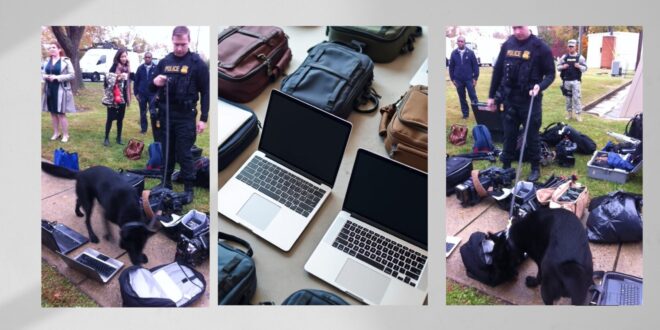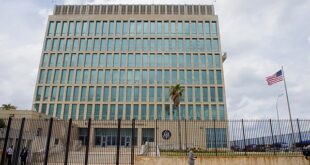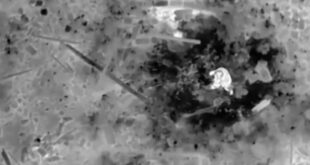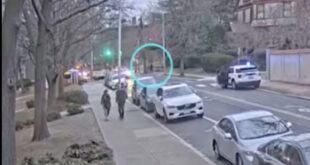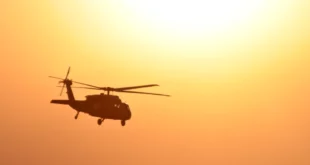COMMENTARY by Susan Katz Keating
What happened this weekend when a man was arrested outside a Donald Trump rally in California? Claims vary. The local sheriff says his officers thwarted an assassination attempt against Trump. The man who was arrested says he meant no harm, and was a member of the media, legitimately doing his job. My professional perspective is, I am inclined to believe the suspect is not an assassin, but I am cringing on behalf of journalism.
According to authorities, the man arrived at the rally on Saturday, and raised red flags while going through a security checkpoint.
“What we do know is he showed up with multiple passports with different names, an unregistered vehicle with a fake license plate and loaded firearms,” Riverside County Sheriff Chad Bianco said at a Sunday news conference. The man was arrested on suspicion of violating California gun laws. Adds Bianco: “I truly do believe that we prevented another assassination attempt.”
READ MORE from Susan Katz Keating: So You Want to Be a War Correspondent
The man vehemently denies any ill intent toward Donald Trump, and said in a video that he did not attend the rally in order to kill the former president. “As of right this second, I could prove everything they said is untrue,” he told the Los Angeles Times. On LinkedIn, he describes himself as “an investigative journalist, documentary filmmaker, and a content producer.”
The Secret Service released a statement saying there was no threat to the former president.
“The U.S. Secret Service assesses that the incident did not impact protective operations and former President Trump was not in any danger,” the statement said.
Here’s why I’m cringing on behalf of my profession.
I am a huge supporter of the 1st Amendment. I also have issues with biased journalists. I do not believe we need to be licensed in order to commit journalism, as some have suggested. But I also expect members of the media, no matter how small their operations, to behave like professionals. They must conduct themselves accordingly in the field. Such as, when covering the types of high profile events where assassins and would-be assassins previously have appeared.
As a journalist, I have covered many events where members of the media were thoroughly screened before getting past “the wire.” This includes presidential campaign rallies for John McCain; the Kenya Ball during Barack Obama’s inaugural; a front row seat at the swearing-in of Donald Trump; and a 2015 event when then-First Lady Michelle Obama and Harry Wales of the UK appeared at Fort Belvoir, VA, to promote the Invictus Games.
At each of these and other events, I knew that anyone who came close to the “principals” would be subjected to extra scrutiny – because proximity increases the potential for lethality. Or, in security terms, unless you are a sniper or a long-distance bomber, the closer you are to a target, the easier it is to hit the mark.
A journalist knows this. A journalist also wants the story, and doesn’t want to get bogged down explaining why, for example, they plan to cover an event while carrying zip-ties, handcuffs, or blowdarts. They plan accordingly. They go light.
In my own practice, I carried only a notebook, pen, i.d., and a press card. I never arrived at an event while carrying documents showing different identities. I never drove a vehicle bearing an unoffical license plate. I never brought a weapon near an event.
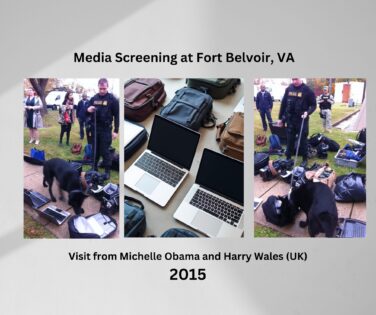
Even so, I have been scrutinized closely.
In October 2015, media screening was tightly controlled at the Michelle Obama / Harry Wales event at Fort Belvoir. Police brought in a bomb-sniffing dog to examine our laptops and backpacks. Everything came out of our bags, as if we were in an open air TSA screening. Army MP’s stood overwatch.
Once we cleared the bomb test, we went through additional screening with the U.S. Secret Service. Agents broke my phone, cracked the screen, and threw my tangerines in the garbage. Journalists couldn’t bring even a factory-sealed snack or water bottle into the venue, a basketball court. All of us in the press corps went more than 12 hours without food or water.
When we arrived for the followon reception at the British Embassy, we went through additional screening. We were kept inside a roped-off corral that allowed us to see and smell the enticing buffet but not partake. In case we were carrying poison, perhaps.
As an aside, a U.S. Army Ranger took pity on me, and ran a recon mission behind the rope line. He brought me some canapés, which helped me rally in order to write up my notes and email them to my editor. But I never left the corral.
Such was the security that surrounded a British prince and an American First Lady. For us journalists, it was part of doing our jobs. It made sense. In 2015 and earlier, threats or plots were uncovered against Barack Obama, including a plot that involved three would-be perps joining ISIS, killing Obama, hijacking an airplane, and bombing Coney Island. As such, the media expected security.
That perspective applies today. Any journalist should know that you can’t expect to attend say, a Trump rally, and not get screened thoroughly.
What really happened, then, at the rally in Coachella?
As I mentioned above, I do not believe that this man planned to kill Donald Trump. But I also do not understand why any journalist would show up at a campaign rally with weapons and a collection of passports. The very thought makes me cringe.
Susan Katz Keating is the publisher and editor in chief at Soldier of Fortune.
 Soldier of Fortune Magazine The Journal of Professional Adventurers
Soldier of Fortune Magazine The Journal of Professional Adventurers


